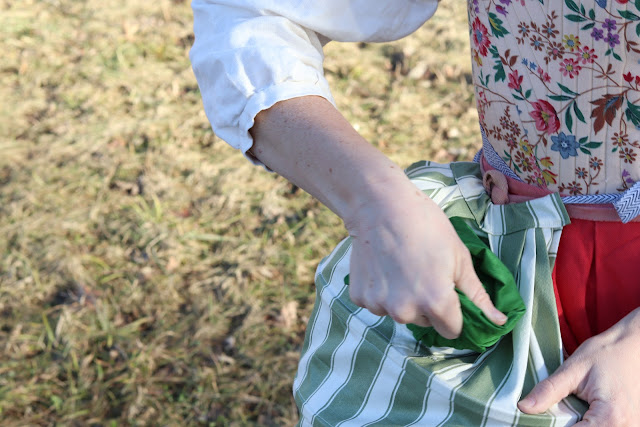While I was making my robe a la francaise last year, I realized, about a week before my event,
"oh crap! I need skirt supports!" In the 1760's, when my gown would have been in style, this meant pocket hoops.
Making pocket hoops slightly scared me. It sounded complicated. However, I didn't have time to avoid this project (as I've done with other projects), as I really did need pocket hoops to wear to the picnic. So, I started researching.
First I looked at the side hoops in the American Duchess Guide to 18th Century Dressmaking. They looked easy to make, which was reassuring, however they weren't actually pocket hoops, just side hoops. They lacked the back and bottom which allows you to actually, you know, use pocket hoops as pockets. If I was going to make these hip-hoop skirt support thingies, gosh darn, they were going to be able to hold stuff.
Next I looked in Corsets and Crinolines by Nora Waugh and found a diagram for actual pocket hoops, complete with a back and a bottom. Just what I needed. The pattern didn't look too hard to size up, I'd just have to figure out the easiest way to actually assemble these things.
Before drafting my pattern, I decided to quickly google "How to Make Pocket Hoops" (Or something along those lines, this was nearly a year ago, so I don't remember exactly.), and I discovered the best resource ever!
I followed the instructions and measurements given and quickly made my pattern. Out of my stash came a green striped polished cotton, green cotton tape for boning channels, heavy-duty, extra-long, zip ties for boning, and cotton twill tape for the waist ties.
My pattern pieces were all cut out of the polished cotton, where the boning channels needed to be was marked, and off to the sewing machine I went to sew those boning channels in place.
The pocket hoops were entirely constructed by machine, and before long I was cutting zip ties to the correct length and inserting them into the channels. I put two zip ties in each channel, as I was afraid one wouldn't be enough to support the weight of my gown.
Zip ties in, waist ties on, and my pocket hoops were done! It only took a couple hours one afternoon - much quicker than I'd anticipated!
They quickly became my new favorite thing. Seriously, you can store anything in these suckers! They make all other pockets look wimpy.
Ok, so perhaps you can't carry a cat in them, because the cat has opinions on that subject, but beyond felines. . .
You can store rolled up petticoats in these pockets.
This would be the green silk petticoat I made to wear with my gown to the Francaise Dinner with the Saint Louis Georgian Sewing Society
It was all hand sewn in the week leading up to the dinner. I surprisingly enjoy hand sewing 18th century petticoats.
The green silk taffeta was a birthday gift from my mom a year and a half ago. (Yeah, it took me a while to get around to actually using this fabric). There was just barely enough for a petticoat - and it nearly perfectly matched the green trim on my francaise!
After sewing up the side seams (with a running back stitch in case you're wondering) and hemming the petticoat, I put my pocket hoops on my dress form and carefully pleated the top edge of the petticoat over the hoops so the hem would hang evenly once finished.
The pleating took some trial and error, but it got done.
The pleats were then basted in place (While I was waiting in the school pick-up line for the kids I nanny apparently, judging by the steering wheel in the back ground.) and I finished the waist with linen tape.
Waist tapes on, the petticoat was done - with a couple days to spare even!
Just like with all my other 18th century petticoats, this one is fastened by first tying the back waist tie around the front, and then the front around the back.
It was rather windy the morning we took these pictures, and the taffeta is rather light, so you'll have to forgive me for the lack of a good picture of the finished petticoat.
I promise you, the hem is actually even, and the green silk petticoat, while a touch shorter than I would prefer, does actually cover my under petticoat completely when the wind isn't being troublesome.
This green silk petticoat was the perfect thing to slightly change the overall look of my francaise for the dinner! I think I prefer it to the matching petticoat I made for this gown.
That said, my favorite part of my 1760's ensemble, is definitely the pocket hoops - because you just can't beat huge pockets!
Why did these hip-bucket thingies ever go out of style???


























Great job
ReplyDeleteLove it!
ReplyDeleteOh, my goodness! Those are awesome!!! Yes, they never should have gone out of style. I always love a large pair of pockets, but those for sure take the cake!
ReplyDeleteHow can you get at the pockets, though under the petticoat and gown??
ReplyDeleteThere are slits in the side seams of my gowns and petticoats that I can reach through to access the pockets. These slits are generally hidden under pleats so they’re not seen.
Delete-Alyssa
Beautiful 😍
ReplyDelete